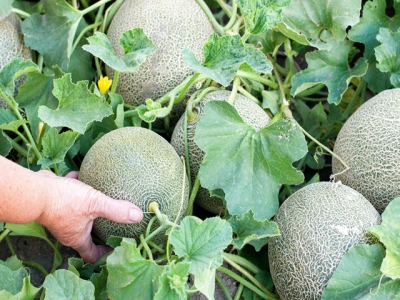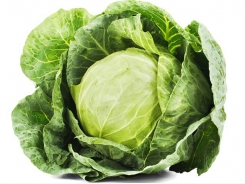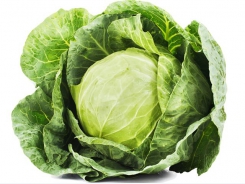8 Tips for Growing The Sweetest Melons

You’ve undoubtedly tasted melons that were a bit, meh. And perhaps others that were sweet enough to qualify as a religious experience. Homegrown melons have a reputation of being tastier than store-bought, but to ensure that’s the case—and to reach the highest pinnacles of sugary goodness you have to provide optimal conditions.
If this gardener followed the eight tips listed here, he’s in for a treat when he eats that melon. Photo: By tchara / shutterstock
Sweetness is graded on the Brix scale, which measures the percentage of solids (everything that’s not water) in juice extracted from fruit. Those solids include not just sugars, but amino acids, proteins, minerals and vitamins—in other words, fruit that is sweeter also has more complex flavors and a better nutrient profile.
Hot Tip: Sweeter fruit has a better nutrient profile.
The Brix rating, often abbreviated ‘Bx’, results from the interplay of genetics, climatic conditions, soil conditions, and ripeness. Below are a few considerations for how to harness those forces in the name of producing the sweetest possible melons.
Start with the Sweetest Varieties
All else being equal, some melons are naturally sweeter than others purely on the basis of genetic composition. Some seed purveyors list the average Brix rating for their melon, but for many common varieties that information is easily obtained through a quick internet search. A Brix rating of 12 is considered pleasantly sweet; 14 is very sweet; and 16 is over-the-moon sweet.
Sow Seeds Early
A long, hot growing season is required for optimal ripeness, and thus sweetness. Start melon seeds indoors in 4-inch pots at least six weeks before the average date of last frost in your area so that the seedlings are already well-established once warm weather hits. If you transplant the seedlings outdoors when the weather is cool, they’ll stop growing; so wait a couple weeks after the average date of last frost to do so, or until nighttime temperatures are consistently above 60 degrees.
Find Your Warmest Microclimate
Heat brings out melons’ sweetness, so make sure to plant them in a location that warms up early in spring and stays hot through the end of September. The south side of a fence or wall is ideal as the structure will absorb heat and light from the sun and reflect it back onto the melons. Locating the melons near a sunny brick patio or other paved surface also helps to create hot microclimate for these tropical plants. Such measures aren’t necessary in southern California, the desert Southwest, and the Deep South, but in cooler climates melons need all the help they can get to reach optimal ripeness.
Accentuate the Sun’s Rays
You can’t do anything to change the climate where you live or the amount of sun your yard gets, but there are a couple tricks for making the most of the available heat in any location. Covering the soil in melon beds with garden-grade black plastic film, which traps heat much like an asphalt surface, is one time-honored trick. You can also install clear plastic or see-through fabric “row covers” over melon beds to create a mini-greenhouse. These must come off in early summer when the plants begin to blossom so that insects can pollinate the flowers. Cover the beds again in late summer to ensure optimal ripening as the weather cools.
Don’t Crowd Your Melons
Melons grow on sprawling vines and do not ripen effectively when grown in cramped quarters. The seedlings are typically planted on mounds (three to a mound) spaced 2 feet apart in rows 6 feet apart. Thin the fruit to three melons per vine, as this will result in more nutrients (and thus sugars) pumped into each melon. If space is an issue, build a sturdy trellis and train the melons up the south side of it — this saves bed space, but also puts the fruit into better contact with the sun’s warming rays.
Sweetness Starts in the Soil
Sugars are produced in the leaves through the process of photosynthesis, and then pumped into the fruit — so the more lush the leafy growth, the higher the Brix rating. To encourage strong growth, blend 4 to 6 inches of composted manure into your melon beds prior to planting. Then add a balanced organic fertilizer (such as a mixed blood meal/bone meal product) every 3 to 4 weeks. Some gardeners elect to plant melons right into their compost pile, which not only provides loads of nutrients, but a bit of extra heat.
Water Heavily — But not During Ripening
Keeping melon leaves lush also requires copious amounts of irrigation. This is best applied with soaker hoses or a drip system, as overhead irrigation encourages fungal disease, which definitely detracts from melons’ sweetness. During the final weeks of ripening, however, excess water dilutes the sugar content of the fruit. So as the fruit approaches its full size, cut back on irrigation, providing only enough water to keep the leaves from completely wilting. It is normal at this stage for some of the older leaves to turn brown.
Pick at the Pinnacle of Ripeness
Even if you do everything else right, no melon is sweet if picked immature. Signs of ripeness include a fruity aroma, a slight softening of the rind, and a hollow sound when you strike the fruit with your knuckle. But the sure sign is how easily the fruit detaches from the vine. If it releases with a slight tug, it’s ripe enough to harvest. However, the highest sugar content is achieved when fruit detaches from the vine on its own (or if this does not occur, when the vine becomes shriveled and dry where it is attached to the melon). The risk at this stage, of course, is that birds and other critters may start eating the fruit before you do.
Related news
Tools

Phối trộn thức ăn chăn nuôi

Pha dung dịch thủy canh

Định mức cho tôm ăn

Phối trộn phân bón NPK

Xác định tỷ lệ tôm sống

Chuyển đổi đơn vị phân bón

Xác định công suất sục khí

Chuyển đổi đơn vị tôm

Tính diện tích nhà kính

Tính thể tích ao




 Cabbage basics: nitrogen & soil balance
Cabbage basics: nitrogen & soil balance  How to manipulate cabbage seedlings
How to manipulate cabbage seedlings